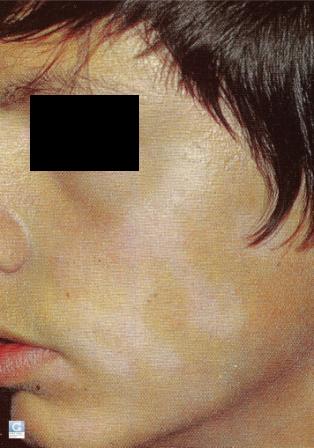White patches in children
Dr Christophe HSU – dermatologist. Geneva, Switzerland
The common causes of white patches on the skin of children are:
1) Pityriasis alba
2) Vitiligo
What is Pityriasis alba?
- Pityriasis alba is a mild dermatitis (skin inflammation).
- This is characterized by multiple oval, mildly scaly, flat hypopigmented (white) patches on the face, arms and upper trunk.
- The borders of these patches are indistinct .
- It occurs in children between the ages of 3 and 16 years and up to 30% of children may be affected during their childhood.
- The patches are not itchy.
- It is often mistaken for a fungal infection.
- The condition tends to become more prominent by sun exposure.

Pityriasis Alba
Treatment and Course of Pityriasis alba
- This is a harmless condition associated with atopy and atopic dermatitis. Treatment consists essentially of moisturizing (moisturising) the skin.
- It can last for months to years with slow spontaneous recovery.
- Sometimes, steroid creams may help.
- Avoid self medication.
- Avoid antifungal creams.
- Avoid excessive washing of the skin with soaps and use a non irritant washing solution.
What is Vitiligo?
- Vitiligo is a patchy loss of skin pigment. The patches are flat, completely white and have distinct borders. Hair within the patches of vitiligo is often white as well.
- Two types of vitiligo are recognized:
- In type A, the vitiligo present as multiple white patches which are generalized and symmetrical. The limbs, face and neck are the areas most commonly involved.
- In type B, the vitiligo presents as localized patches in a segmental distribution. This type is common in children.
- Type A vitiligo tends to continue to spread with new lesions appearing over years whereas
- Type B vitiligo tends to spread rapidly then stops after about one year.
- The cause of vitiligo is not entirely known. Some people with vitiligo have a higher incidence of associated diabetes mellitus and thyroid disease.
- more on vitiligo
How do we treat vitiligo?
- Your doctor will prescribe one or more treatments as follows:
- Topical steroid creams. This can induce repigmention in some patients.
- PUVA, is a combination treatment involving the use of a drug called Psoralen (P) and then exposing the skin to untraviolet A (UVA). Psoralen can either be used in the lotion form to be applied on the skin or as tablets to be taken orally to make the skin sensitive to UV light. Patients treated with PUVA must be prepared to undergo therapy for a year or longer for optimuni results. Such treatment is best supervised by a dermatologist.
- Camouflage cosmetics. Some cosmetics can provide very good colour match to normal skin. Camouflage cosmetics are particularly useful for white patches on the face and back of the hands.
- Sunscreens. Areas affected by vitiligo are prone to sunburn. It is advisable to use sunscreens on affected areas which are exposed to sunlight.
- The response to treatment varies with each person and site affected.
Contributors:
Dr Christophe HSU – dermatologist. Geneva, Switzerland
National Skin Centre. Singapore
العربية 中文-汉语 中文-漢語 Deutsch Español Italiano 日本語 Português русский язык 한국어 Tagalog
Category : dartres - Modifie le 11.29.2009Category : pityriasis alba - Modifie le 11.29.2009Category : vitiligo - Modifie le 11.29.2009


